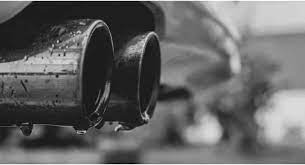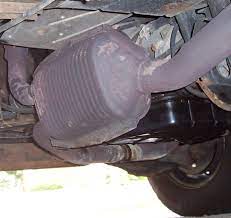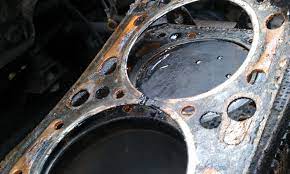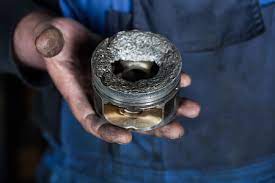Why Might You See Water Coming From Your Exhaust?
The question is does water dripping from your exhaust pipe indicate you have an issue or is it completely normal? In this article we are going to look at the reasons you might see liquid dripping from your vehicle's exhaust and explain whether you should be concerned about this.
Why Would Water Drip Out of Your Exhaust Pipe?
In this section we are going to look at a few reasons you may see fluid dripping from your tailpipe. Some will be perfectly normal and nothing to worry about but sometimes there may be other indicators that tell you that you have an actual problem.
It Might Be Condensation
As part of the internal combustion engine process gases such as carbon dioxide, nitrogen and water in the form of steam are created. As these combustion gases are released into the exhaust system they start to cool down.

The further through the system these gases go the cooler they get and eventually water vapors revert back to liquid water. This will form on the metal of the inside of the exhaust pipe and will be pushed along by the gases as they continue through the system.
Eventually the water will form droplets and dribble out of the exhaust. As the exhaust heats up with driving it gets too hot for the water to condense inside the tail pipe so it escapes only as steam after that. If the leaking fluid stops after you have driven for a while then all is normal and there is nothing to fix.
Condensation in the Catalytic Converter
Aside from the natural condensation from the combustion process the activity of the catalytic converter creates even more H2O in the exhaust gases. This is because the more harmful gasses are being converted to less harmful ones leaving water as a by-product.
Again these water vapors make it out to the tail pipe and when the pipe is still cool it will allow condensation. Running the engine for a while will heat up the tailpipe and prevent the condensation from settling and stop the water dripping.

This is all still very normal and will be resolved within a few minutes. It does no harm and does not indicate an actual fixable issue.
Head Gasket Failure
Now we reach issues that might actually be a problem and the head gasket can be a real doozy. Condensation is not an issue but if the drips do not stop you have a bigger problem because that is not just water you are seeing.
If your head gasket blows you may also see white smoke coming from your tailpipe . The water you are seeing may in fact be engine coolant which although mainly water has other chemicals added to increase its boiling point.

This is potentially a big problem that you need to fix without delay. If you see the white smoke, water droplets and signs of air in your coolant reservoir you might have a blown head gasket and potentially high repair costs.
The longer you try to drive with a blown head gasket the more other engine problems you can cause. If the problem gets too bad you may need a whole new engine.
EGR Cooler Fault
The Exhaust Gas Recirculation (EGC) cooler is found in newer model cars but most often diesel engine vehicles. As the name suggests it is intended to cool down your exhaust gases before they enter the intake.
As with the rest of the engine, coolant runs through this part pulling heat away from the superheated gases that are passing through. If the cooler develops a crack then coolant can get inside and mix with the gases.

This leaking coolant can make its way out through the tailpipe and look like drops of water. If this tailpipe fluid smells sweet then it is not just water, it is a mixture of water and other chemicals that make up coolant also known as antifreeze.
Issues with Pistons or Rings
Damaged piston rings and pistons will only cause excessive tail pipe condensation if the head gasket is also blown. There will be burning of engine oil involved in this as well which will create very noticeable blue smoke.
The oil enters the combustion chambers rather than just acting as lubrication for the pistons. It makes for bad engine emissions which create more water in the exhaust and a poorly performing engine over all.
How Much Will It Cost to Fix Water in Your Exhaust?
As mentioned, normal condensation from the exhaust gases and activity of the catalytic converter is very normal and usually only happens when you first start up and the tailpipe is still cool. As the exhaust gases run for a while the whole system heats up so the condensation stops.
This is not a fault and there is nothing to fix in this situation. If the water does not stop and is accompanied by some other indicators you might have an actual problem and thus could be costly.
Depending on your car and the complexity of the fix you might spend $1000 - $2000 replacing a head gasket. The biggest cost in this case being the labor. If you additionally have issues with the engine pistons you could be looking at replacement costs between $1000 - $5000 on top of the head gasket repair.
These are important and difficult repairs so leaving them unresolved can make even more trouble for you. Not resolving these issues can do more damage up to and including completely destroying your engine.
The cost of replacing an engine will vary but it can start around $4500 - $6000 for basic level engines. If you have something more high performance you can quickly find yourself spending over $10,000 for a new engine.
Essentially sometimes it would be cheaper to scrap a car and get a new one than to replace an engine. So do not ignore the signs of a blown head gasket or piston issues.
What if It's Oil and Not Water?
This is a good question. You may think you are seeing drops of water but a glance at the ground will unmistakably tell you if it's motor oil. You should never see motor oil coming from your exhaust that is supposed to be in an enclosed system.
You may be seeing this for a number of reasons but essentially somewhere in your engine oil is leaking out and making its way through the exhaust. You will want to get this leak located and you may need to make a few other repairs as well.
Conclusion
Water dripping from your exhaust soon after you start the engine and while you are idling is really no big deal. It’s just science in action and does not mean a thing. If it does not stop after driving for a short while you may have an issue.
White or blue smoke may indicate an issue in the engine that is causing this water. If the water coming out smells sweet then this is actually coolant and it should not be trickling from your exhaust. You will want to dig deeper to find the issue and get it fixed very quickly.
Link To or Reference This Page
We spend a lot of time collecting, cleaning, merging, and formatting the data that is shown on the site to be as useful to you as possible.
If you found the data or information on this page useful in your research, please use the tool below to properly cite or reference Tow Ratings as the source. We appreciate your support!
-
<a href="http://towratings.net/blog/why-might-you-see-water-coming-from-your-exhaust/">Why Might You See Water Coming From Your Exhaust?</a>
-
"Why Might You See Water Coming From Your Exhaust?". Tow Ratings. Accessed on April 20, 2024. http://towratings.net/blog/why-might-you-see-water-coming-from-your-exhaust/.
-
"Why Might You See Water Coming From Your Exhaust?". Tow Ratings, http://towratings.net/blog/why-might-you-see-water-coming-from-your-exhaust/. Accessed 20 April, 2024
-
Why Might You See Water Coming From Your Exhaust?. Tow Ratings. Retrieved from http://towratings.net/blog/why-might-you-see-water-coming-from-your-exhaust/.